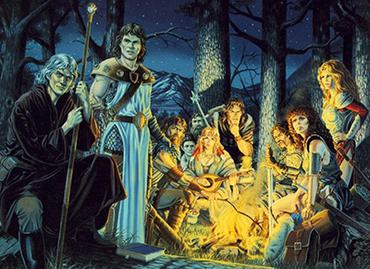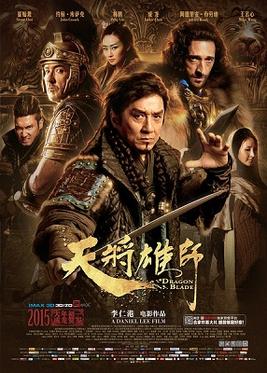This week, I wanted to compare and contrast two mechanics from different editions of Dungeons & Dragons used in character creation and development: Proficiencies v. Feats.
By "proficiencies," I'm referring weapon proficiencies in the 1st and 2nd editions of AD&D, which determined how well a PC used particular weapons. There were also non-weapon proficiencies, but they operated rather differently and are outside the scope of this discussion.
Weapon proficiencies were a significant departure from the approach of Original Dungeons & Dragons and the Basic lines. In those versions, all classes could, by default, use all permissible weapons without penalty. So, for example, a Cleric could wield a Mace, Hammer, Flail, Club or Staff equally well from the start. By contrast, in AD&D1 and AD&D2, a 1st level Cleric was only proficient in two permissible weapons and had a -3 To-Hit penalty when using the others.
I understand why some people are unhappy about the change. However, the reason that I've adopted weapon proficiencies for my rules set, Sorcery & Steel, is because of a further development in Unearthed Arcana (1985), namely Weapon Specialization, which allowed Fighters to invest additional weapon proficiencies for additional bonuses. This is one of the few things that I liked from UA.
While I allow all classes to Weapon Specialize and to go beyond Double Specialization, I use this mechanic to make Fighters pop as a class, since they have the most weapon proficiencies to invest. This makes them clearly the best at general combat at higher levels. Conversely, I also use weapon proficiencies to make Magic-Users both tougher and more versatile at lower levels, by giving them many more initial weapon proficiencies and many more additional weapon proficiencies as they level.
Since their introduction in 3rd edition D&D (2000), feats are a markedly different way to improve and customize PCs: feats are much broader than proficiencies and can give a character many different kinds of special capabilities (e.g., Deft Hands, Enlarge Spell, Investigator, etc.). I feel the addition of feats reflects the influence of computer RPGs, such as the all-time great Fallout (1997), whose Perks grant also special effects, most of which are not obtainable via the normal level up system.
Feats are also one of the mechanics that shifted the power level of 3rd edition D&D from heroic to super heroic.
Some people liked this shift. However, it does add to the GM's burden and the increased power level for a D&D-type game breaks verisimilitude for me.
Feats also don't work as well at the tabletop because of the additional complexity since this adds a layer of number crunching on top of the skill system and since some feats add additional subsystems. Additionally, many feats are linked together into feat trees but not all feat trees are equal. So, this incentivizes players to spend hours pouring over long lists of feats to find optimal combinations.
This also encourages players to plan their PCs levels in advance. Some people like this mini-game. However, my tastes run toward faster and more casual gameplay.
By "proficiencies," I'm referring weapon proficiencies in the 1st and 2nd editions of AD&D, which determined how well a PC used particular weapons. There were also non-weapon proficiencies, but they operated rather differently and are outside the scope of this discussion.
Weapon proficiencies were a significant departure from the approach of Original Dungeons & Dragons and the Basic lines. In those versions, all classes could, by default, use all permissible weapons without penalty. So, for example, a Cleric could wield a Mace, Hammer, Flail, Club or Staff equally well from the start. By contrast, in AD&D1 and AD&D2, a 1st level Cleric was only proficient in two permissible weapons and had a -3 To-Hit penalty when using the others.
I understand why some people are unhappy about the change. However, the reason that I've adopted weapon proficiencies for my rules set, Sorcery & Steel, is because of a further development in Unearthed Arcana (1985), namely Weapon Specialization, which allowed Fighters to invest additional weapon proficiencies for additional bonuses. This is one of the few things that I liked from UA.
While I allow all classes to Weapon Specialize and to go beyond Double Specialization, I use this mechanic to make Fighters pop as a class, since they have the most weapon proficiencies to invest. This makes them clearly the best at general combat at higher levels. Conversely, I also use weapon proficiencies to make Magic-Users both tougher and more versatile at lower levels, by giving them many more initial weapon proficiencies and many more additional weapon proficiencies as they level.
 |
| Only one starting weapon proficiency? |
Since their introduction in 3rd edition D&D (2000), feats are a markedly different way to improve and customize PCs: feats are much broader than proficiencies and can give a character many different kinds of special capabilities (e.g., Deft Hands, Enlarge Spell, Investigator, etc.). I feel the addition of feats reflects the influence of computer RPGs, such as the all-time great Fallout (1997), whose Perks grant also special effects, most of which are not obtainable via the normal level up system.
Feats are also one of the mechanics that shifted the power level of 3rd edition D&D from heroic to super heroic.
Some people liked this shift. However, it does add to the GM's burden and the increased power level for a D&D-type game breaks verisimilitude for me.
Feats also don't work as well at the tabletop because of the additional complexity since this adds a layer of number crunching on top of the skill system and since some feats add additional subsystems. Additionally, many feats are linked together into feat trees but not all feat trees are equal. So, this incentivizes players to spend hours pouring over long lists of feats to find optimal combinations.
This also encourages players to plan their PCs levels in advance. Some people like this mini-game. However, my tastes run toward faster and more casual gameplay.







.JPG/729px-Frank_Mentzer_-_Lucca_Comics_%26_Games_2014_(cropped).JPG)










